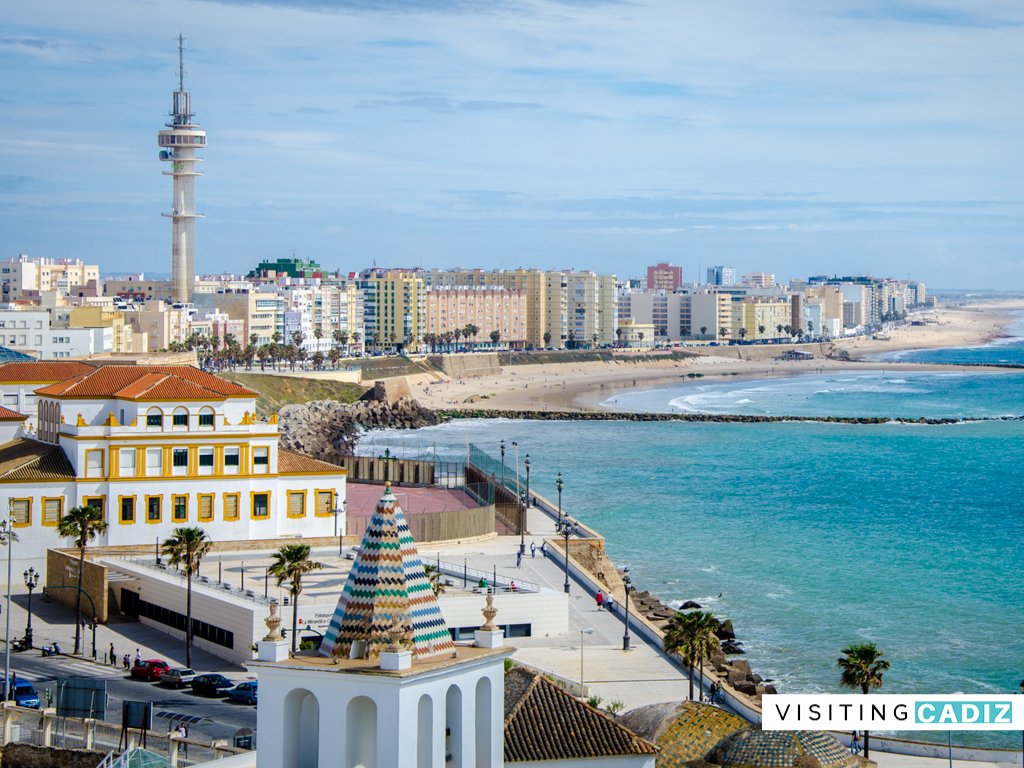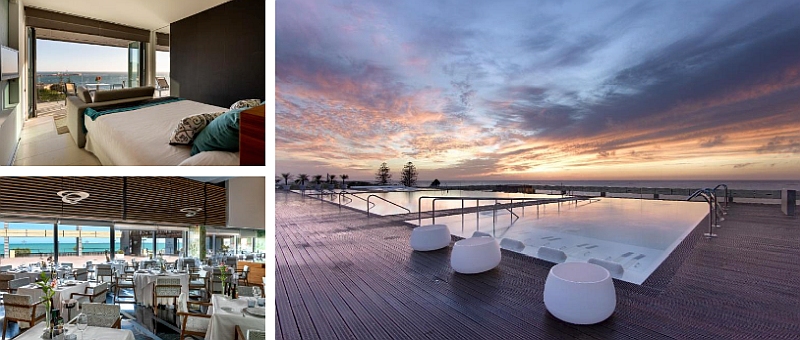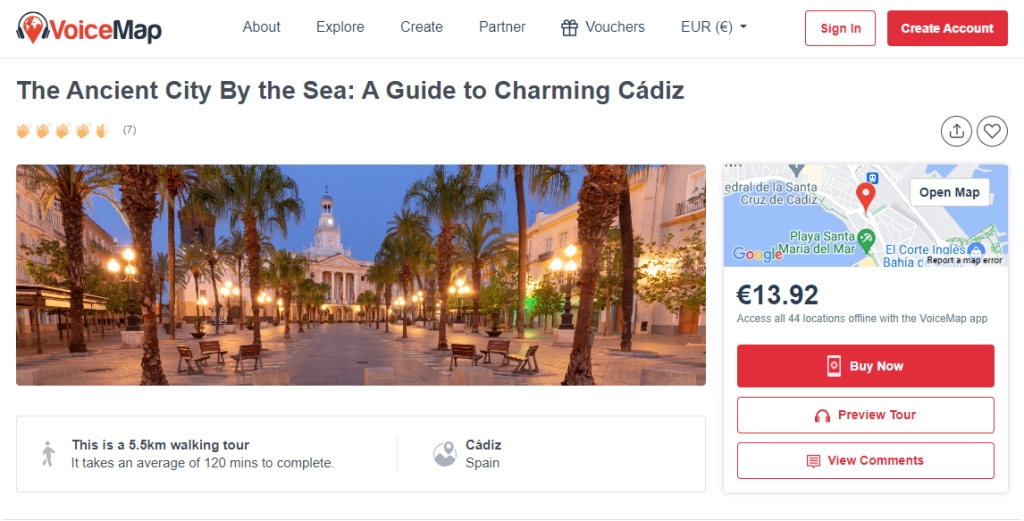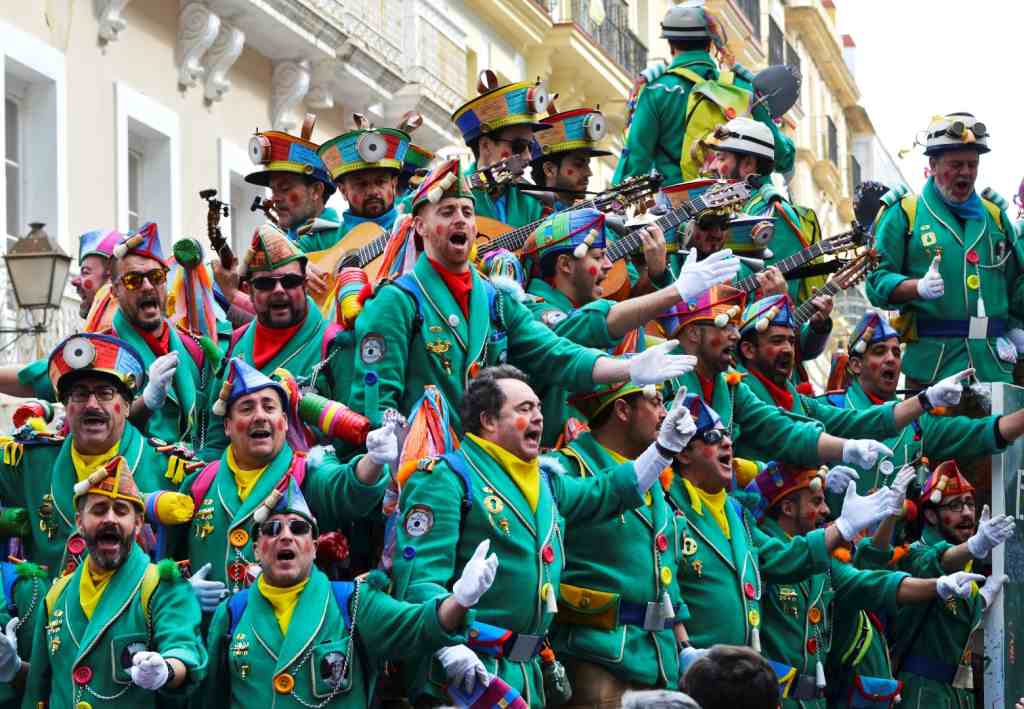Cádiz is the second-most populous city in the Bay of Cádiz and one of the most economically vibrant, driven largely by its shipbuilding industry, port activity, and a bustling free-trade zone. Its economy also relies heavily on tourism, which is boosted by stunning beaches, traditional festivities, and a remarkable historical heritage.

Beaches
Cádiz is known for its golden, fine sandy beaches, most of which are urban, with the exception of Playa de Cortadura:

- La Caleta Beach: The smallest beach in the city, isolated from the others.
- Playa de la Victoria: Often acclaimed as the best urban beach in Europe, it stretches for about 3 km and is the first beach in Spain to achieve AENOR certification for quality.
- Playa de Cortadura: Cádiz’s longest beach, at 3.9 km.
- Puntales Beach: The least known in the city.
- Torregorda Beach: The furthest from the city centre.
Read more about the beaches in Cádiz here.
Getting to Cádiz
- By Road: The N-IV and A4 highways connect Cádiz to the north, while the N-340 links it to the south.
- By Air: The closest airport is Jerez de la Frontera, just 35 km from Cádiz. Other nearby airports include Seville (125 km) and Gibraltar Airport (138 km).
If you are arriving by car then read our essential guide on where to park in Cádiz here.
Staying in Cádiz
I (Clive) have stayed three times in the fantastic Parador hotel in Cádiz. and loved the experience each time.

But, there are plenty of places to choose from in Cádiz from Hostels to apartments and plush hotels. You can look at many options over at Booking.com.
Exploring Cádiz
The best way to get to know Cádiz is by wandering through its narrow streets, admiring its monuments and plazas, and discovering its hidden gems. As you explore, you’ll be captivated by the beauty, atmosphere, and sea breeze that define this charming city.

Buy the audio guide at Voicemap here: https://voicemap.me/tour/cadiz/the-ancient-city-by-the-sea-a-guide-to-charming-cadiz
Nightlife and Festivities
Cádiz’s nightlife is alive and thriving in its many bars and public squares. Every plaza, especially Plaza Mina and Plaza de España, becomes a meeting point where locals gather to chat and laugh. Cádiz’s warm nights and friendly atmosphere make socialising easy and fun.

The city is known for its celebrations, whether they’re annual events or spontaneous gatherings. Notable events include the Trofeo Ramón de Carranza, celebrated with beach barbecues after the Cádiz Football Club’s preseason match. Cádiz also celebrates the Fiesta del Boquerón, the Erizá de Cádiz, and its lively Semana Santa (Holy Week), keeping the city’s social calendar vibrant.
Read more about nightlife in Cádiz here.
However, the biggest celebration in Cádiz—and perhaps all of Spain—is the Carnival. In February, Cádiz fills with music, colour, and costumes, with the ancient Manuel de Falla theatre at its heart. Here, chirigotas, quartets, choirs, and ensembles compete to be the most creative and entertaining.

Gastronomy
Cádiz’s culinary heritage is a treat for food lovers. Notable dishes include fresh seafood like pescaíto frito, morena en adobo, and bienmesabe, as well as a variety of tapas. Signature dishes blend land and sea, such as atún encebollao, papas con chocos (potato and cuttlefish stew), and berza gaditana, a garbanzo stew with meat, which is traditionally enjoyed during tosantos.
Read our in depth article about what to eat in Cádiz here.
For sweets, Cádiz offers delights like tocino de cielo, pestiños, and piñonate, adding to its unique culinary landscape.
A brief history of Cádiz
Cádiz has always been a strategic city, as the oldest Phoenician settlement in the West. According to tradition, it was founded by the Tyrians 80 years after the Trojan War (around 1104 BC). It was here that Hannibal set sail to conquer Italy.
During the Roman era, Cádiz flourished, achieving significant prosperity and, for a time, became one of the Empire’s most densely populated cities. The construction of amphitheatres and aqueducts marked this period, and over 500 eques (notable citizens) resided here, rivalling the prominence of Padua and even Rome.
In 522, the Byzantines captured the city, but it was reconquered by the Visigoths in 620, only to be overtaken again in 711 by Tariq Ibn Ziyad at the Battle of Guadalete. During the Reconquista, the Spanish Crown established royal shipyards in the bay, ushering in a period of great maritime expansion and exploration.
From Gadir to Cádiz
- The Phoenicians originally founded Gadir in 1100 BCE, creating the most important Phoenician colony in the West. The Greeks later called it Gadeira, and the Romans renamed it Gades. Under Roman rule, Cádiz thrived as a civitas federata, a title awarded by Julius Caesar.
- The city experienced a decline in the 3rd century, coinciding with the weakening of the Roman Empire. In 522, Cádiz fell to the Byzantines, only to be retaken by the Visigoths in 620. The city came under Muslim rule following the Battle of Guadalete in 711.
- In 1264, Christian troops reclaimed Cádiz, leading to a resurgence in maritime activity. With the establishment of the Spanish Crown’s shipyards and the discovery of America, Cádiz regained its status, becoming a departure point for explorers such as Christopher Columbus and Álvar Núñez Cabeza de Vaca.
- In 1553, the pirate Barbarossa attempted to seize Cádiz but failed. However, the city was sacked by Francis Drake in 1587 and attacked by an Anglo-Dutch fleet under the Duke of Essex in 1596, spurring the Crown to fortify it against future assaults.
- In 1805, a Franco-Spanish fleet departed from Cádiz to confront the British under Admiral Nelson, who defeated the Spanish at the Battle of Trafalgar, marking the end of Spain’s maritime dominance.
Find out more about the history of Cádiz by visiting one of the many museums in the city.
Modern History and Decline
- Cádiz played a pivotal role in Spain’s War of Independence against Napoleonic France and saw the drafting of Spain’s first liberal constitution in 1812—a liberal charter later repealed by Ferdinand VII.
- In 1868, Cádiz was the birthplace of the Liberal Revolution, which led to Spain’s 1869 democratic constitution. With the establishment of the First Spanish Republic, Cádiz declared itself an independent canton, a stance later retracted under Alfonso XII. However, the loss of Spain’s colonies in 1898 marked the beginning of Cádiz’s decline.
- Cádiz played a notable role during the Spanish Civil War, serving as a base for the Nationalist faction. In 2003, it was awarded the “Plaque of Honour of the Order of Constitutional Merit” by Spain’s Ministry of the Presidency.
Climate around Cádiz
Cádiz enjoys a Mediterranean climate with Atlantic influences, boasting an average annual temperature of 18.1°C and over 3,000 hours of sunshine each year. Summer temperatures average 27.7°C, while winter temperatures drop to a mild 7.7°C. The city receives around 604 mm of rainfall annually, spread over an average of 74 rainy days.
Landmarks and Attractions
From beautiful beaches to lively festivals, Cádiz offers plenty to see and do. A must is a summer evening of tapas in the Barrio del Pópulo or Barrio de La Viña. The city has blossomed as a vibrant tourist, urban, and cultural destination.

Iconic Monuments in Cádiz
- Puerta de Tierra – This architectural monument marks the entrance to the city. It was designed by architect Torcuato Cayón in the 18th century. More here.
- Reina Sofía Cultural Centre – Formerly the Military Government Tower, this building once housed the first optical telegraph in Andalusia.
- Gran Teatro Falla – Built in 1884, this theatre replaced the original wooden Grand Theatre, which was destroyed by fire in 1881. More here.
- Cádiz Cathedral – Known locally as the “New Cathedral,” this 18th-century structure, built by order of Alfonso X, includes an exquisite crypt and three chapels. A highlight is the silver Corpus Christi monstrance from 1684, weighing nearly a tonne. More here.
Additional landmarks include the Roman Theatre, Salt Factory, San Sebastián Castle, Candelaria Bastion, Fuerte de San Lorenzo del Puntal, and the Casa Palacio de las Cadenas.
Festivals and Events in Cádiz: A Year of Tradition and Culture
Cádiz, renowned for its rich history and vibrant culture, hosts a variety of unique events and festivals throughout the year. From traditional processions to international festivals, this Andalusian city offers celebrations for every taste. Here’s an overview of Cádiz’s main festivals and events, month by month.
January
- Three Kings Parade (5th January): The year kicks off with the traditional Three Kings Parade, where Their Majesties journey through the streets of Cádiz, delighting crowds with sweets and festive cheer.
February – March
Cádiz Carnival: Declared an International Tourist Interest event, the Cádiz Carnival is a dazzling showcase of creativity and humour. The celebration features competitions among groups performing in the Gran Teatro Falla, such as:
- Choirs: Large groups travelling through the city on floats, singing the iconic tanguillo de Cádiz.
- Comparsas: Smaller groups performing poetic and emotional songs accompanied by guitars, drums, and bass drums.
- Chirigotas: Known for their witty lyrics and comedic style, often using the traditional carnival whistle.
- Quartets: Four-person acts blending music and comedy theatre.
- This iconic festival culminates in vibrant street performances and lively gatherings.
March
- Music in Lent: Two weeks before Easter, enjoy traditional Lent music concerts across the city.
April
- Holy Week: Holy Week in Cádiz rivals those of other Spanish cities in grandeur and devotion. Processional parades begin on Palm Sunday and conclude on Easter Sunday with the Brotherhood of the Resurrection. The narrow streets of the historic old town create a breathtaking backdrop for these solemn events.
May
- Manuel de Falla Classical Music Festival: A tribute to the renowned composer, this festival attracts classical music lovers to Cádiz every spring.
- International Puppet Festival: Cádiz comes alive with puppetry from around the globe, delighting audiences young and old.
June
- Corpus Christi: This religious procession features children in First Communion attire, civil and military dignitaries, and local brotherhoods parading through the city with bands playing solemn marches.
- Night of San Juan: A magical evening marked by the burning of effigies, known as Juanillos, at midnight. After the bonfires, participants leap over the embers three times while casting written wishes into the flames, believing this ritual will make them come true.
- Tapas Route: Savour the best of Cádiz’s gastronomy during this culinary festival.
July
- Cádiz Folklore Festival: This international event showcases traditional music and dance from various cultures, enriching the city’s summer atmosphere.
August
- Nights of the Angels: Four days of storytelling, flamenco performances, and concerts fill the city’s summer nights with charm and excitement.
- Carranza Football Trophy: A classic football tournament paired with the tradition of beach barbecues on Playa Victoria.
September
- The Atlantic Film Festival (Alcances): Held in the first half of September, this festival highlights independent films and documentaries, focusing on cultural and social themes.
- Seafood Gastronomic Route: Indulge in Cádiz’s culinary delights with dishes inspired by the sea.
October
- Patron Saint Festival, Virgen del Rosario: A celebration honouring Cádiz’s patron saint with processions and cultural activities.
- Ibero-American Theatre Festival: This internationally renowned event showcases theatre productions from Spain and Latin America.
- Tosantos Market Festival: At the end of October, market stalls transform with creative displays of produce, celebrating the harvest season.
November
- Spanish Music Festival: A celebration of national music, featuring performances that highlight the richness of Spanish composition.
- Contemporary Dance Festival: Showcasing cutting-edge dance performances, Cádiz embraces modern artistry in this dynamic festival.
December
- International Puppet Festival: The streets of Cádiz host puppet performances from all over the world, captivating audiences with creative storytelling.
Everything You Need to Know Before Visiting Cádiz: Beaches, History, and Local Tips
Cádiz’s history stretches back over 3,000 years to the Phoenician settlement of Gadir. Over centuries, Romans, Visigoths, and Muslims all left their imprint. This rich past has shaped the city’s culture, architecture, and maritime legacy. You can still explore many of these layers through its museums and historic sites across the old town.
Playa de la Victoria is often named Europe’s best urban beach, perfect for swimming and evening walks. La Caleta offers a smaller, more local feel, while Playa de Cortadura provides peace and space away from the crowds. Each beach has its own personality—read the full guide in the main article to discover which one suits your style best.
Cádiz is easily reached via the A4 motorway or by train from Seville in around 90 minutes. The closest airport is Jerez de la Frontera, only 35 km away. Seville and Gibraltar airports are also convenient alternatives, making Cádiz one of the most accessible coastal destinations in southern Spain.
February and March are particularly lively months thanks to the world-famous Cádiz Carnival, filled with music, satire, and dazzling costumes. Spring and summer bring Holy Week processions, flamenco nights, and open-air concerts. Each season offers something different—find out which festival aligns with your travel dates in the full event calendar.
Seafood dominates the local cuisine. You can’t go wrong with pescaíto frito (fried fish), atún encebollao (tuna with onions), or papas con chocos (potato and cuttlefish stew). For dessert, try tocino de cielo or pestiños. Each bite reflects Cádiz’s maritime heritage and Andalusian charm. Explore our full gastronomy section for more local favourites.
The nickname, meaning “The Little Silver Cup,” reflects the city’s radiant charm and the way its old town shimmers by the sea. Locals use it affectionately to describe the warm, reflective light that bathes the bay. There’s more to this poetic name than meets the eye—learn about its origins in the main article.
I’ve been living in this lovely area of Western Andalucia for the last 20 years or so and dedicate most of my time to the running of English language tourist information websites for the towns of Cádiz, Ronda, Grazalema, the famous or infamous Caminito del Rey, and also Wildside Holidays, which promotes sustainable and eco-friendly businesses running wildlife and walking holidays in Spain. My articles contain affiliate links that will help you reserve a hotel, bus, train or activity in the area. You don’t pay more, but by using them you do support this website. Thankyou!

